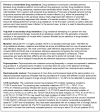HIV-1 protease and reverse transcriptase mutations for drug resistance surveillance
- PMID: 17197813
- PMCID: PMC2573394
- DOI: 10.1097/QAD.0b013e328011e691
HIV-1 protease and reverse transcriptase mutations for drug resistance surveillance
Abstract
Objectives: Monitoring regional levels of transmitted HIV-1 resistance informs treatment guidelines and provides feedback on the success of HIV-1 prevention efforts. Surveillance programs for estimating the frequency of transmitted resistance are being developed in both industrialized and resource-poor countries. However, such programs will not produce comparable estimates unless a standardized list of drug-resistance mutations is used to define transmitted resistance.
Methods: In this paper, we outline considerations for developing a list of drug-resistance mutations for epidemiologic estimates of transmitted resistance. First, the mutations should cause or contribute to drug resistance and should develop in persons receiving antiretroviral therapy. Second, the mutations should not occur as polymorphisms in the absence of therapy. Third, the mutation list should be applicable to all group M subtypes. Fourth, the mutation list should be simple, unambiguous, and parsimonious.
Results: Applying these considerations, we developed a list of 31 protease inhibitor-resistance mutations at 14 protease positions, 31 nucleoside reverse transcriptase inhibitor-resistance mutations at 15 reverse transcriptase positions, and 18 non-nucleoside reverse transcriptase inhibitor-resistance mutations at 10 reverse transcriptase positions.
Conclusions: This list, which should be updated regularly using the same or similar criteria, can be used for genotypic surveillance of transmitted HIV-1 drug resistance.
Figures
Similar articles
-
Limited increase in primary HIV-1C drug resistance mutations in treatment naïve individuals in Ethiopia.J Med Virol. 2015 Jun;87(6):978-84. doi: 10.1002/jmv.24110. Epub 2015 Feb 3. J Med Virol. 2015. PMID: 25649964
-
[Evolution of HIV resistance mutations in the Valme referral center].Enferm Infecc Microbiol Clin. 2007 Feb;25(2):159. doi: 10.1016/s0213-005x(07)74247-7. Enferm Infecc Microbiol Clin. 2007. PMID: 17288915 Spanish. No abstract available.
-
HIV-1 Transmitted Drug Resistance Mutations in Newly Diagnosed Antiretroviral-Naive Patients in Turkey.AIDS Res Hum Retroviruses. 2016 Jan;32(1):26-31. doi: 10.1089/AID.2015.0110. Epub 2015 Oct 21. AIDS Res Hum Retroviruses. 2016. PMID: 26414663 Free PMC article.
-
Polymorphism in HIV-1 non-subtype B protease and reverse transcriptase and its potential impact on drug susceptibility and drug resistance evolution.AIDS Rev. 2003 Jan-Mar;5(1):25-35. AIDS Rev. 2003. PMID: 12875105 Review.
-
Update of the drug resistance mutations in HIV-1: 2004.Top HIV Med. 2004 Oct-Nov;12(4):119-24. Top HIV Med. 2004. PMID: 15516709 Review. No abstract available.
Cited by
-
P2' benzene carboxylic acid moiety is associated with decrease in cellular uptake: evaluation of novel nonpeptidic HIV-1 protease inhibitors containing P2 bis-tetrahydrofuran moiety.Antimicrob Agents Chemother. 2013 Oct;57(10):4920-7. doi: 10.1128/AAC.00868-13. Epub 2013 Jul 22. Antimicrob Agents Chemother. 2013. PMID: 23877703 Free PMC article.
-
Extensive host immune adaptation in a concentrated North American HIV epidemic.AIDS. 2018 Sep 10;32(14):1927-1938. doi: 10.1097/QAD.0000000000001912. AIDS. 2018. PMID: 30048246 Free PMC article.
-
Drug resistance surveillance in resource-poor settings: current methods and considerations for TB, HIV, and malaria.Am J Trop Med Hyg. 2011 Feb;84(2):192-9. doi: 10.4269/ajtmh.2011.10-0363. Am J Trop Med Hyg. 2011. PMID: 21292884 Free PMC article. Review.
-
Potential of small-molecule fungal metabolites in antiviral chemotherapy.Antivir Chem Chemother. 2017 Aug;25(2):20-52. doi: 10.1177/2040206617705500. Epub 2017 Jul 23. Antivir Chem Chemother. 2017. PMID: 28737040 Free PMC article. Review.
-
Sequence editing by Apolipoprotein B RNA-editing catalytic component [corrected] and epidemiological surveillance of transmitted HIV-1 drug resistance.AIDS. 2008 Mar 30;22(6):717-25. doi: 10.1097/QAD.0b013e3282f5e07a. AIDS. 2008. PMID: 18356601 Free PMC article.
References
-
- Violin M, Cozzi-Lepri A, Velleca R, Vincenti A, D’Elia S, Chiodo F, et al. Risk of failure in patients with 215 HIV-1 revertants starting their first thymidine analog-containing highly active antiretroviral therapy. AIDS. 2004;18:227–235. - PubMed
-
- Little SJ, Holte S, Routy JP, Daar ES, Markowitz M, Collier AC, et al. Antiretroviral-drug resistance among patients recently infected with HIV. N Engl J Med. 2002;347:385–394. - PubMed
Publication types
MeSH terms
Substances
Grants and funding
LinkOut - more resources
Full Text Sources
Medical


